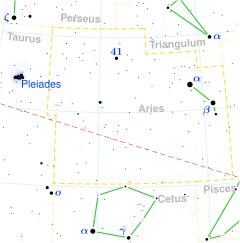Tau1 Arietis
Tau1 Arietis, Latinized from τ1 Arietis, is the Bayer designation for a triple star system[10] in the northern constellation of Aries. Based upon an annual parallax shift of 6.41 mas,[1] it is approximately 510 light-years (160 parsecs) distant from Earth. The combined apparent visual magnitude is 5.27,[2] making it faintly visible to the naked eye.
 | |
| Observation data Epoch J2000 Equinox J2000 | |
|---|---|
| Constellation | Aries |
| Right ascension | 03h 21m 13.62411s[1] |
| Declination | +21° 08′ 49.5150″[1] |
| Apparent magnitude (V) | 5.27[2] |
| Characteristics | |
| Spectral type | B5 IV[3] |
| U−B color index | –0.53[2] |
| B−V color index | –0.06[2] |
| Astrometry | |
| Radial velocity (Rv) | +14[4] km/s |
| Proper motion (μ) | RA: +20.98[1] mas/yr Dec.: –21.80[1] mas/yr |
| Parallax (π) | 6.41 ± 0.73[1] mas |
| Distance | approx. 510 ly (approx. 160 pc) |
| Absolute magnitude (MV) | −0.66[5] |
| Details | |
| Mass | 5.0 ± 0.1[6] M☉ |
| Radius | 3.4–3.6[7] R☉ |
| Luminosity | 234[5] L☉ |
| Rotational velocity (v sin i) | 30[8] km/s |
| Age | 54.8 ± 5.4[6] Myr |
| Other designations | |
| Database references | |
| SIMBAD | data |
The inner pair form an eclipsing binary system, with the brightness of the pair decreasing by 0.06 in magnitude during an eclipse of the primary.[11] The third component is located at an angular separation of 0.810 arcseconds and has a magnitude of 8.17.[10] The primary component is a subgiant star with a stellar classification of B5 IV.[3] It has around 3.5[7] times the size of the Sun with five[6] times the Sun's radius.
This system is a member of the Cas-Tau OB association of stars that share a common motion through space.[12]
References
- van Leeuwen, F. (November 2007), "Validation of the new Hipparcos reduction", Astronomy and Astrophysics, 474 (2): 653–664, arXiv:0708.1752, Bibcode:2007A&A...474..653V, doi:10.1051/0004-6361:20078357.
- Crawford, D. L.; Barnes, J. V.; Golson, J. C. (1971), "Four-color, H-beta, and UBV photometry for bright B-type stars in the northern hemisphere", The Astronomical Journal, 76: 1058, Bibcode:1971AJ.....76.1058C, doi:10.1086/111220.
- Lesh, Janet Rountree (December 1968), "The Kinematics of the Gould Belt: an Expanding Group?", Astrophysical Journal Supplement, 17: 371, Bibcode:1968ApJS...17..371L, doi:10.1086/190179.
- Evans, D. S. (June 20–24, 1966), "The Revision of the General Catalogue of Radial Velocities", in Batten, Alan Henry; Heard, John Frederick (eds.), Determination of Radial Velocities and their Applications, Proceedings from IAU Symposium no. 30, 30, University of Toronto: International Astronomical Union, p. 57, Bibcode:1967IAUS...30...57E.
- Anderson, E.; Francis, Ch. (2012), "XHIP: An extended hipparcos compilation", Astronomy Letters, 38 (5): 331, arXiv:1108.4971, Bibcode:2012AstL...38..331A, doi:10.1134/S1063773712050015.
- Tetzlaff, N.; Neuhäuser, R.; Hohle, M. M. (January 2011), "A catalogue of young runaway Hipparcos stars within 3 kpc from the Sun", Monthly Notices of the Royal Astronomical Society, 410 (1): 190–200, arXiv:1007.4883, Bibcode:2011MNRAS.410..190T, doi:10.1111/j.1365-2966.2010.17434.x.
- Pasinetti Fracassini, L. E.; et al. (February 2001), "Catalogue of Apparent Diameters and Absolute Radii of Stars (CADARS) - Third edition - Comments and statistics", Astronomy and Astrophysics, 367 (2): 521–524, arXiv:astro-ph/0012289, Bibcode:2001A&A...367..521P, doi:10.1051/0004-6361:20000451.
- Abt, Helmut A.; Levato, Hugo; Grosso, Monica (July 2002), "Rotational Velocities of B Stars", The Astrophysical Journal, 573 (1): 359–365, Bibcode:2002ApJ...573..359A, doi:10.1086/340590.
- "tau01 Ari". SIMBAD. Centre de données astronomiques de Strasbourg. Retrieved 2012-08-11.
- Eggleton, P. P.; Tokovinin, A. A. (September 2008), "A catalogue of multiplicity among bright stellar systems", Monthly Notices of the Royal Astronomical Society, 389 (2): 869–879, arXiv:0806.2878, Bibcode:2008MNRAS.389..869E, doi:10.1111/j.1365-2966.2008.13596.x.
- Malkov, O. Yu.; et al. (February 2006), "A catalogue of eclipsing variables", Astronomy and Astrophysics, 446 (2): 785–789, Bibcode:2006A&A...446..785M, doi:10.1051/0004-6361:20053137.
- de Zeeuw, P. T.; et al. (January 1999), "A HIPPARCOS Census of the Nearby OB Associations", The Astronomical Journal, 117 (1): 354–399, arXiv:astro-ph/9809227, Bibcode:1999AJ....117..354D, doi:10.1086/300682.